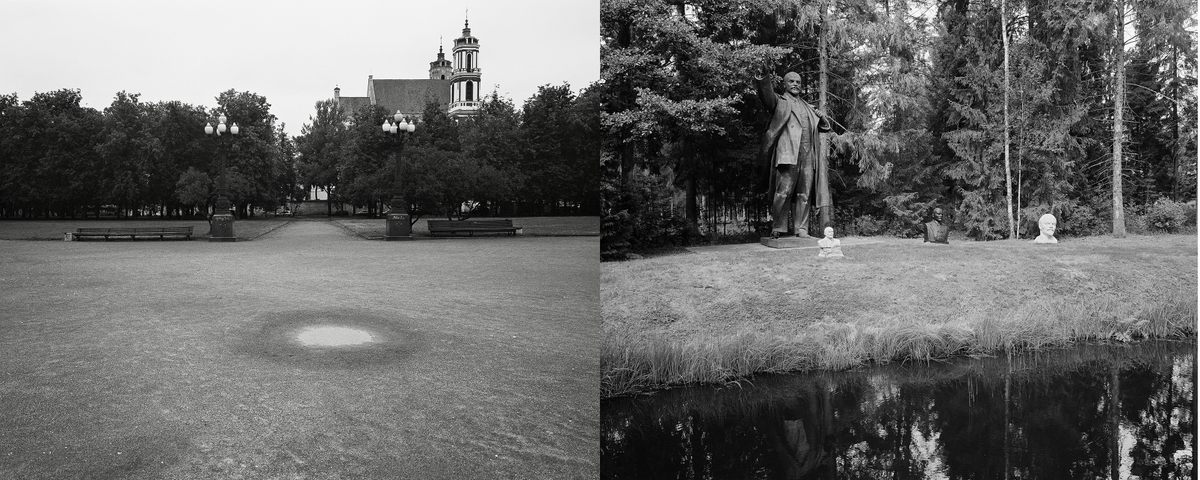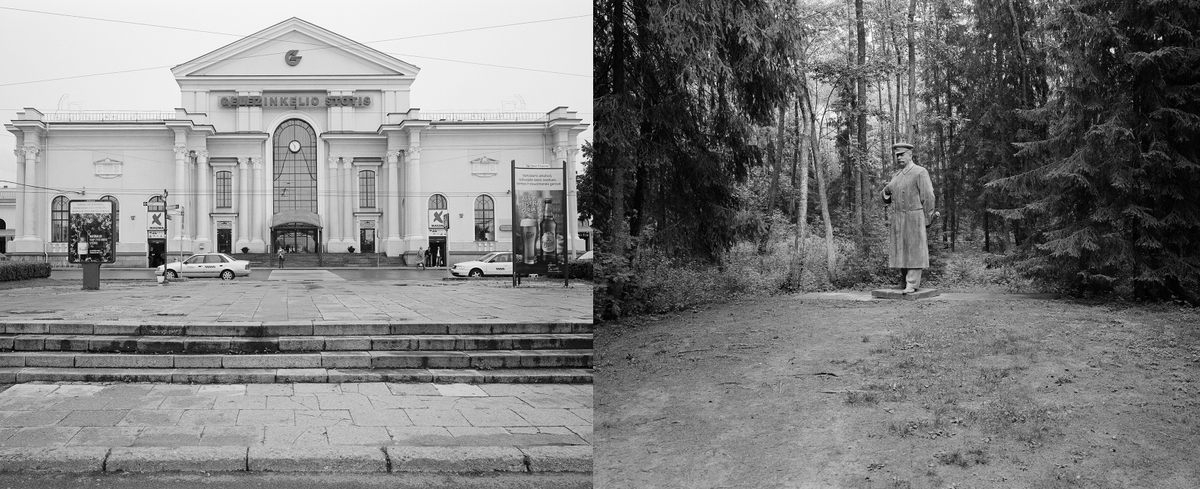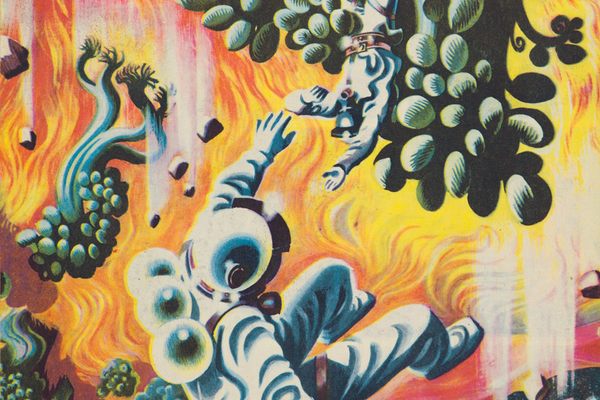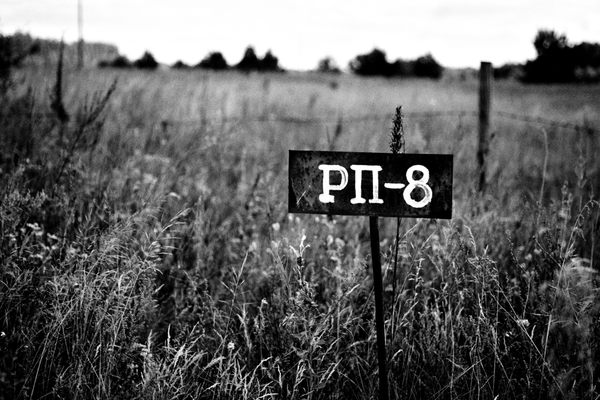
Meet the Photographer Hunting for the Scars of Soviet Rule
Matthew Moore captures places where monuments once stood—and then finds the statues as well.
Pop culture has its crocodile hunters, house hunters, ghost hunters, and more. Matthew Moore, a photographer currently based in Maryland, has lived on and off in Czechia for the past 20 years. In that time, he has become fascinated by public relics of Soviet power. So he became a statue hunter or, more precisely, a void hunter, seeking out the places where since-relocated Soviet monuments once stood, and then the monuments themselves.
“When I first moved to the Czech Republic in 2000, I found out about the ‘pink tank’ in Prague, and became obsessed by it,” Moore says, referring to the Soviet Tank Monument—an actual military tank used by Russians during the Czech invasion, left on display in a city square for decades. Following the Velvet Revolution of 1989, it was famously painted bubble-gum pink by artist David Černý. Though the tank had been relocated to the Military Technical Museum of Lesany by the time Moore was living in Prague, he was determined to find the spot where it once stood.
This turned out to be a difficult mission for a non-native—particularly before Google Maps and smartphones. The Czech government had taken great pains to erase the remaining traces of Soviet occupation, removing once-ubiquitous statues of Lenin and Stalin, renaming streets and squares, and reclaiming public spaces. The original location of the tank wasn’t associated with any name or address, and though it may have been recorded somewhere in newspaper accounts, Moore didn’t then read or speak Czech.

So he used an old detective technique. “I asked my Czech girlfriend to call her mother,” he says. “I specifically remember her mother directing us, in Czech, which tram line to take to go find this random square where a tank no longer was. She thought we were crazy.”
Mom may have had a point. The square, when they finally found it, was pretty much empty, without even a plaque to acknowledge the history—hardly the stuff of epic photographs, or even a good day trip. But the episode sparked an enduring fascination with what Moore now thinks of as scars on the post-socialist landscape, nearly invisible reminders of dominance, violence, and trauma. The search has taken him all over Eastern Europe.
“Many locals, especially the young ones who may not have lived through the Soviet occupation, walk by these spaces without thinking about it,” he says. “It’s easy to pass by them so often that they just blend into the environment. Being an outsider gave me a different perspective. I trained my eye to see the scars.”

The scars can be hard to find, even when you know what you’re looking for. Over the next decade, as internet maps became widely available, Moore developed a process that begins with what he calls “creative Googling”: combing the internet for digital maps and personal travel blogs with clues about places likely to have once held communist monuments. When he finds a promising location, he prints out old photos that offer some context—nearby buildings, for example—that he can use to orient himself in the modern landscape. From there, he triangulates the perspective to determine where the statues once stood, even if all other reminders of them are gone.
The results are unusual for a landscape photograppher: a flower bed, a parking lot, a Tesco with a red Honda Civic out front, seemingly purposeless hunks of concrete. “I’m not looking for beautiful spaces,” he says. “I’m pointing you at a weird thing, in a weird way, which makes the viewer feel weird. That’s intentional. My perspective is very distant and detached. There’s a sense of something being off, of emptiness or oddness in the picture. The photos of empty pedestals are meant to be a little unsettling in that way.”
More recently, he has also become interested in the ultimate fates of the discarded or displaced monuments—the odd and eerie places statues of Lenin and Stalin have ended up. He has found some stored behind buildings, others gathered in private parks. In all cases, they have been relocated far from the towns and cities where they once stood, stripped of their power to intimidate.

These images of what Moore calls “idols” complement the spaces. “At first I was only interested in the scars, or the disappearance of the statues. But I soon realized that removing the statue and transforming the space where it was is only part of the healing process,” Moore says. “In order for this project to be complete I needed to investigate both parts: How do societies heal the scar where the statue stood, but also how do they strip it of the power to intimidate and cause pain?”
He sees wide implications for his project in the United States. “I think Europeans have a better understanding than Americans that statues are actually a form of propaganda,” he says. “We Americans seem to latch on to these objects as if they are a true representation of our history. They are not. Statues and monuments almost always convey a false history—a history that was chosen based on our current political beliefs. That is the whole point of the project. To inform the conversation by examining how societies control historical narratives through interventions in the landscape.”
Moore walked Atlas Obscura through some of his detective work. A show of his “Post-Socialist Landscapes” project will be on display at Blue Sky Gallery in Portland, Oregon, in late 2021/early 2022.

![<em>Stalin: Budapest & Memento Park, Hungary</em> (2017): “The people of Budapest tore down a huge statue of Stalin in 1956, an act of defiance that launched a revolution. Ultimately that revolution was put down, but the modern monument you see here, which stands in the place of the former statue, is really powerful. It’s designed to look like it’s breaking through the ground. An hour away, Memento Park houses the relief that was at the bottom of the Stalin statue [next to another statue, of Lenin]. To me, the way it’s displayed—lying flat on the ground—it’s almost like a body count."](https://img.atlasobscura.com/XQzSJtv8PyIgtAmtRU_vYrG2695BUNNRcr7k-LXZYmE/rt:fill/w:1200/el:1/q:81/sm:1/scp:1/ar:1/aHR0cHM6Ly9hdGxh/cy1kZXYuczMuYW1h/em9uYXdzLmNvbS91/cGxvYWRzL2Fzc2V0/cy9mNzNiYzhhMzYx/NTAxNGIyYTFfTW9z/YWljLTMuanBn.jpg)


















Follow us on Twitter to get the latest on the world's hidden wonders.
Like us on Facebook to get the latest on the world's hidden wonders.
Follow us on Twitter Like us on Facebook